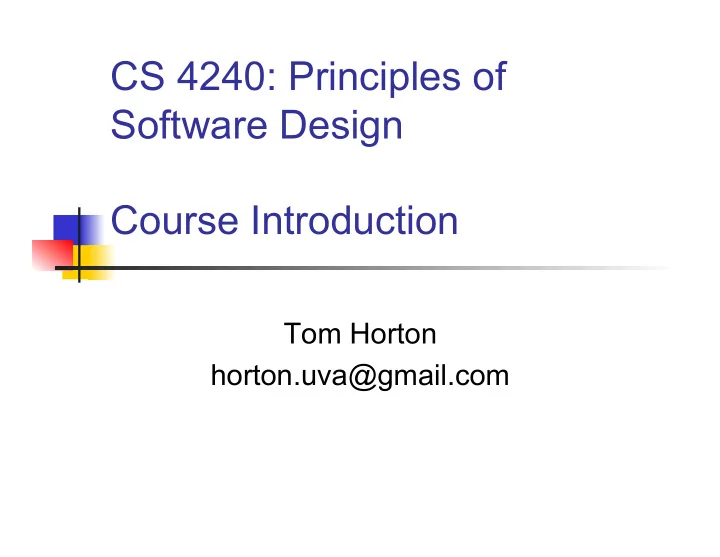

CS 4240: Principles of Software Design Course Introduction Tom Horton horton.uva@gmail.com
Official Course Description: This course focuses on techniques for software design in the development of large and complex software systems. Topics will include software architecture, modeling (including UML), object-oriented design patterns, and processes for carrying out analysis and design. More advanced or recent developments may be included at the instructor's discretion. The course will balance an emphasis on design principles with an understanding of how to apply techniques and methods to create successful software systems.
Prerequisite: CS 216/2150 with a C- or better. Or: at least two semesters experience in OO programming, in Java,… with an understanding of inheritance, interfaces and polymorphism, plus… understanding of basic data structures and libraries that support them.
Grading: HWs, Project Some aspects of this still TBD Homeworks (30%): a set of 3 to 6. Some possibly done in pairs. Project structure may affect number. Project (25%): Groups of 3. Balance of grade percentage may be adjusted.
SW Design Portfolio HWs and project will require some kind of report. Will be collected together to form a software design portfolio. Might be useful in job interviews. The point: I want your class work- products to be in a form that could demonstrate you have design skills
Class Participation I do expect you to attend class! Participation penalty: up to 5% Occasional quizzes, exercises, activities during classes. Record your participation. Maybe 10 or so total. No penalty for missing a few. Email me about reasonable absences.
Grading: Exams Exam 1: 20%. Tuesday, Sep 28. (Drop deadline is Oct. 5.) Exam 2: 20%. Tuesday, Nov. 16. (W/D deadline is Nov. 12.) Final Quiz: 5%. Take-home. Issued Tues., December 7 (last day of class), due by Monday, Dec. 13. (Possible alternative. 3 exams, the last during the final exam session, 9am, Dec. 17.)
Readings: You don’t have to buy a text book, but… Required reading using books and articles on-line or on-reserve Some of these are in Safari on-line library, accessible with virginia.edu IP address VPN or read on grounds
First Reading Assignment Chapter 1 of Design Patterns Explained: A New Perspective on Object-Oriented Design (2 nd edn). By Alan Shalloway and James Trott. By Tuesday, August 31
Languages, Tools, Etc. Documents submitted in PDF Mix of Collab and webpages for course- site Collab will be used for submission Files bundled with Zip or tar Drawing tool or UML tool (more later) Programming language(s)….
Java We’ll use Java a lot at first. Why? We all know it. It’s a solid OO language. Rich set of libraries and frameworks. A lingua franca in OO writings. Widely used (e.g. Android) Strong tool support: IDEs, GUI, code generation, reverse engineering Others? C#, C++, Objective C, Python, Ruby Project?
Eclipse Etc. I’ll encourage you to use Eclipse Others possible: Netbeans, IntelliJ Explore large applications (hundreds of files, complex inheritance hierachies) Run JUnit tests Integrate with version control (svn), build tools (ant) Execute refactoring operations Debug Integrate with servers (e.g. Tomcat)
A Course Emphasis This Term: Professional SW Engineering Skills SW Construction tools Build scripts. Why? ant with Java Unit tests. JUnit. Test-first development. Use of libraries. E.g. log4j, java.concurrent, others Version control. Subversion, Redmine
Less Emphasis This Term Building according to a process CS3240 does a lot of that We’ll talk about it Context for design Requirements and design But the project will be less about this than, say, recent offerings of CS3240 No Unified Process. Maybe a little agile.
Back to the Project Will emphasize forming and documenting a design Implementation to demonstrate design’s success. Team-based development System as part of larger code-base, made up of components, etc. Not from 100% from scratch
Question: What kind of project interests you?
Course Topics (part 1): Context for design Design principles Modularity, etc. Functional design (Briefly) Non-OO design Code Smells, Refactoring Object-oriented design OO Analysis OO modeling: Unified Modeling Language (UML)
Course Topics (part 2): Object-oriented Design (cont’d) Abstraction, Inheritance, Interfaces Packages Libraries, Frameworks Design Patterns Software Architecture Higher-level, system level Plug-ins (Eclipse, Firefox, etc.) Case studies: code examples
Possible Advanced Topics: Some flexibility: User-interface design? Concurrent systems? Web-based systems? Ruby on Rails? Non-OO design? (C, web languages)
What Is Software Design? What would you say?
Class Activity: Groups of 3 Mod 0 Groups: List two things you do when you “do SW design” Mod 1 Groups: List some things that are part of a SW design Mod 2 Groups: List who might use design “outputs” and for what
What is Software Design? Maybe different ways to think about it? Goals Activities Inputs, Outputs Techniques, Skills Principles Descriptions
Your Answers:
What makes a design “good”? Qualities? Principles or rules?
Your Answers:
Someone’s Answers…. Book: Java Design: Building Better Apps & Applets (2/e, 1999) Peter Coad and Mark Mayfield The book proposes that: Java has features support good OO design principles
Coad’s book: design activities Design activities: Identify purpose and features 1. Select classes 2. Sketch a user-interface (UI) 3. Work out dynamics with scenarios 4. Build a class diagram 5.
Coad’s book: design principles Design principles Design with composition rather than 1. inheritance Design with interfaces 2. Design in interfaces 3. Design with notification 4.
Recommend
More recommend